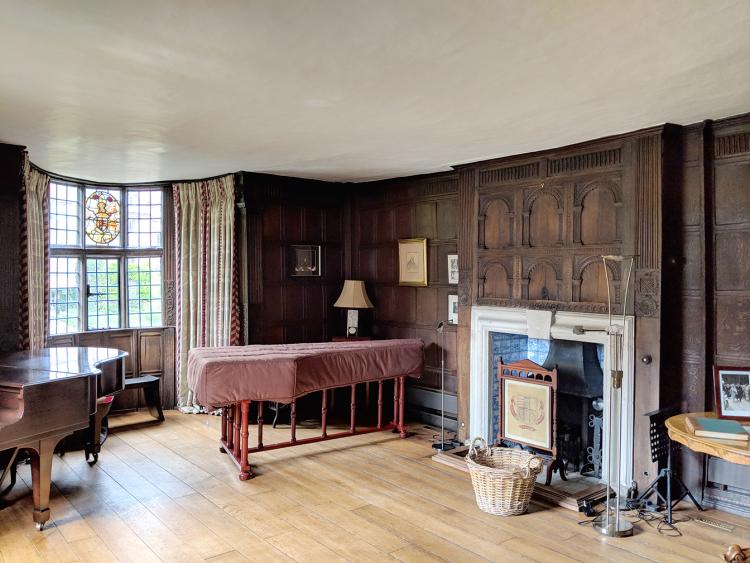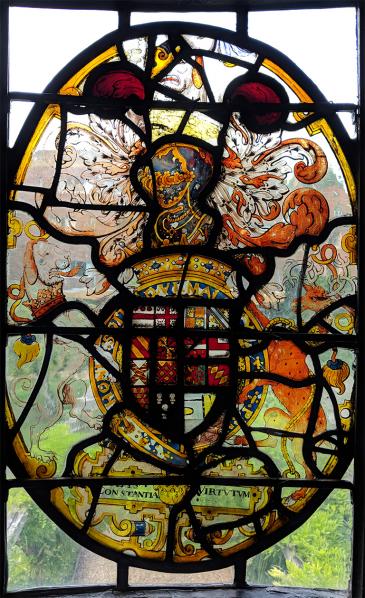
The Essex Chamber is named after Robert Devereux, 2nd Earl of Essex. Devereux was Chancellor of the University from 1598 until his execution in 1601. He is reputed to have stayed in this chamber.
For a period up until 1897, this room was the President’s Study, with the current Study (before the installation of the linenfold panelling) being a Drawing Room.
The panelling of the Essex Chamber is identical to that of the Long Gallery.
The oval wooden table, seen on the right of the photograph, was made from the wood of the walnut-tree that stood at the north end of the Walnut-Tree Building, which was cut down in the late 1880s to make way for the development of Friars Building and the new Chapel [label on underside of table].
 The Arms of Robert Devereux, 2nd Earl of Essex, are prominently on display in stained glass in the bay window. One of his ancestors was Anne, the sister of Elizabeth Woodville: the Woodville arms can be seen in one of the sixteen quarters of his arms: right-most in the second row from the top.
The Arms of Robert Devereux, 2nd Earl of Essex, are prominently on display in stained glass in the bay window. One of his ancestors was Anne, the sister of Elizabeth Woodville: the Woodville arms can be seen in one of the sixteen quarters of his arms: right-most in the second row from the top.
Devereux had no known special affiliation with Queens’ College that might justify the presence of his arms here. However, there is a potential connection between Devereux and the President of 1579–1614, Humphrey Tindall, in that Tindall had officiated in 1578 at the second marriage of Devereux’s mother Lettice Knollys to Robert Dudley, Earl of Leicester, to whom Tindall was chaplain. So Tindall and Devereux would have been known to each other.
These Essex arms have a close similarity of style with arms of the college, also in an oval frame, dated 1589, on display in the Long Gallery oriel window. It would be reasonable to infer (a) that both are of a similar period, and (b) that they might both have come from the same workshop. These arms must date from after 1588, when Devereux was elected to the Order of the Garter. But if they were made as early as 1589, then there are difficulties tying that date in with the other elements of the Essex legend.
The date of Devereux’s visit to Queens’ is debatable: see below. Also debatable is whether a short visit by a nobleman might have been sufficient justification (a) for his achievement of arms to have been created in stained glass, and (b) for a room to be named after him. After all, Queens’ had been known to entertain royalty with no such memorials. No entries in the college accounts have been found for the commissioning either of this glass or of the similar 1589 glass of the college arms: one speculates that Tindall might have paid for both himself, just as he paid for so much of the fitting-out of the Long Gallery at about the same time. We might never know the true reason why these arms were created and displayed in Queens’, nor why this room is named for the Earl of Essex.
When did Devereux visit Queens’?
Fuller, in his account of the year 1597/8, wrote:
Upon the death of William Cecill Lord Burghly, Robert Devereux Earl of Essex was chosen Chancellour of the University. Comming to Cambridge he was entertained in Queens Coll: where the Room he lodged in, is called Essex Chamber to this day, and where the pleasant comedy of LELIA was excellently acted before him.
[The History of the University of Cambridge, by Thomas Fuller, 1655, Section VII, ¶31, p. 156; Edition by Nichols, 1840, p. 219; Edition by Prickett & Wright, 1840, p. 296]
That passage is the source of the legend of the naming of the room, and has been frequently quoted in later histories. On the date of Devereux’s visit to Queens’, and his seeing a performance of Lælia, Fuller is almost certainly incorrect. Searle observed:
The college accounts make no mention of a comedy at this time, nor indeed of the earl’s visit.
[The History of the Queens’ College of St Margaret and St Bernard in the University of Cambridge, by William George Searle, Vol. 2, 1871, p. 390]
Moore Smith went further and asserted (a) that there was no record of Devereux ever having visited Cambridge during his tenure of the office of Chancellor, but (b) that there was a record of Devereux having seen a comedy at Queens’ on Saturday March 1st 159⅘:
… the next Morning [1st March] after my [lord the] Earl of Essex & ye rest were come, The Orator entertayned them in the Regent Howse, with an oration, it being no Congregation. After that oration they herd Dr Whitaker read, & then went to Dyner to Queenes Coll: wher after Dyner they had a Comedy, the day being turned into night.
[Lælia, a Comedy acted at Queens’ College, by George Charles Moore Smith, 1910, pp. viii–xv, quoting Baker MSS xxxii. pp. 529 et seq]
Moore Smith went on to construct a case that the Comedy was Lælia. This case was supported by an Epigram of John Weever:
In Georgium Meriton, & Georgium Mountaine.
Your entertaine (nor can I passe away)
Of Essex with farre-famed Lælia;
Nor fore the Queen your service on Queens day
When such a Maister with you beareth sway,
How can Queenes College ever then decay?
No. Yet Queenes College evermore hathe beene
Is, and will be, of Colleges the Queene.
[Epigrammes in the oldest cut, and newest fashion, by John Weever, 1599, The fourthe weeke, Epig. 19; Edition by R.B. McMerrow, p. 73]
George Meriton and George Mountaine were Fellows of Queens’ who had acted in the performance of Lælia seen by the Earl of Essex, and who were subsequently asked by Essex to act with him in a performance of a Device at Whitehall in front of the Queen on the anniversary of her accession in November 1595. John Weever was at that time an undergraduate at Queens’.
So Robert Devereux, 2nd Earl of Essex, was present in Queens’ College on March 1st 159⅘. Whether it was that night that he stayed in the chamber afterwards to bear his name, we have no evidence.
Links
The Essex Wing exterior.
Further reading
1886: The Architectural History of the University of Cambridge, by Robert Willis and John Willis Clark, Vol. 2, pp. 28–30. (OCLC 6104300)
1949: The President’s Lodge, Queens’ College Cambridge, in The Antique Collector, Vol. 20, No. 3 (May–June 1949), pp. 69–76. (ISSN 0003-5858)
1959: An Inventory of the Historical Monuments in the City of Cambridge, by the Royal Commission on Historical Monuments (England), Part II, p. 175. (online version)
2016: The Heraldry of Queens’ College, Cambridge, by David Broomfield.